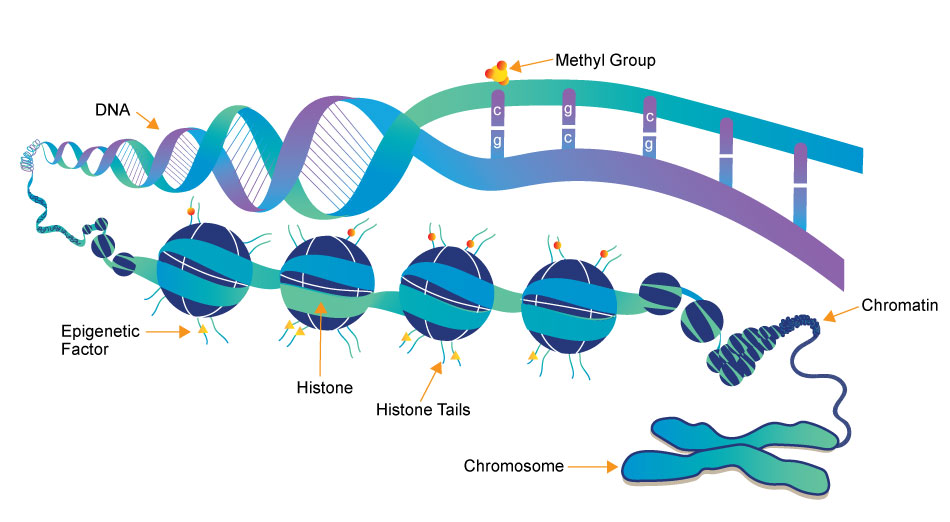Epigenetics


Epigenetics research delves into the molecular mechanisms that control gene expression and cellular traits without altering the underlying DNA sequence. One crucial aspect of this field is the role of small molecules, which act as powerful regulators of epigenetic modifications. These small compounds, typically comprising a few dozen to a few hundred atoms, have emerged as essential tools in understanding and manipulating the epigenome.
- DNA Methylation Inhibitors: Small molecules like 5-azacytidine and 5-aza-2'-deoxycytidine are DNA methyltransferase inhibitors. They block the addition of methyl groups to DNA, leading to DNA demethylation. This can reactivate silenced genes, potentially offering therapeutic avenues for conditions like cancer.
- HDAC inhibitors: HDACs remove acetyl groups from histone proteins, contributing to gene repression. Small molecule HDAC inhibitors, such as Vorinostat and Romidepsin, can reverse this process by increasing histone acetylation, allowing genes to be more accessible for transcription. These inhibitors are being explored for cancer therapy and other conditions.
- Histone Methyltransferase Inhibitors: Small molecules like GSK126 inhibit specific histone methyltransferases, affecting histone methylation patterns. This can alter gene expression, making them promising candidates for cancer and other diseases with epigenetic dysregulation.
- RNA Modulators: Small molecules can also target non-coding RNAs involved in epigenetic regulation. For instance, small molecules called small interfering RNAs (siRNAs) can be designed to target and degrade specific long non-coding RNAs, influencing gene expression.
- Epigenetic Reader Domain Inhibitors: These small molecules target proteins that recognize and bind to specific epigenetic marks. Examples include inhibitors of bromodomain-containing proteins (BET inhibitors), which can disrupt gene regulation by interfering with protein-DNA interactions.
Small molecules in epigenetics research not only provide insights into the fundamental biology of gene regulation but also hold immense promise for developing novel therapeutics. Their ability to selectively modulate specific epigenetic marks and pathways has led to ongoing clinical trials and drug development efforts for various diseases, including cancer, neurological disorders, and inflammatory conditions. Understanding and harnessing the power of these small molecules is at the forefront of modern epigenetics research, offering new hope for precision medicine and targeted therapies.
3 key components involved in the regulation of epigenetic modifications
Epigenetics Writer
Epigenetics writers are enzymes responsible for adding chemical marks or modifications to DNA or histone proteins. These marks include DNA methylation (addition of methyl groups to DNA) and histone modifications (such as acetylation, methylation, phosphorylation, etc.).
Epigenetics Reader
Function: Epigenetics readers are proteins that can recognize and bind to specific epigenetic marks on DNA or histones. These reader proteins interpret the epigenetic code and facilitate downstream cellular processes, such as gene activation or repression.
Epigenetics Eraser
Function: Epigenetics erasers are enzymes responsible for removing or reversing epigenetic marks on DNA or histones. This process allows for the dynamic regulation of gene expression and the resetting of epigenetic states during various stages of development and in response to environmental changes.
-
JAK2 抑制剂
NS-018 是一种口服生物利用度高的小分子抑制剂,针对 Janus-associated kinase 2 (JAK2) 和 Src-family kinases,具有潜在的抗肿瘤活性。 -
JAK2 抑制剂
NS-018 maleate 是一种针对 JAK2 的 ATP-竞争性小分子抑制剂,在 Ba/F3-JAK2V617F 细胞中的 IC50 为 470nM。相较于其他 JAK 家族激酶,如 JAK1、JAK3 和 酪氨酸激酶2,对 JAK2 的选择性高出30-50倍。 -
EZH2 抑制剂
Lirametostat(CPI-1205)是一种高效(生化 IC50 = 0.002 μM,细胞 EC50 = 0.032 μM)且选择性的 EZH2 抑制剂。- George L.Joun, .et al. , bioRxiv, 2025, Jan 8
-
KDM 抑制剂
2,4-Pyridinedicarboxylic Acid (2,4-PDCA) is an inhibitor of histone lysine-specific demethylases that targets on JMJD2A (KDM4A), KDM4C, KDM4E (IC50, 1.4 µM), KDM5B (IC50, 3 µM), KDM6A and other 2-oxogynases. -
KDM2/7 抑制剂
TC-E 5002 是一种选择性的组蛋白去甲基化酶 KDM2/7 亚家族抑制剂(IC50 值分别为 KDM7A 0.2 µM、KDM7B 1.2 µM、KDM2A 6.8 µM、KDM5A 55 µM、KDM4C 83 µM、KDM6A >100 µM 和 KDM4A >120 µM)。在体外实验中,能够抑制 HeLa 和 KYSE-150 癌细胞的生长。 -
PRMT6 抑制剂
EPZ020411 是一种强效且选择性的 PRMT6 抑制剂,其 IC50 为 10 nM,对 PRMT6 的选择性是 PRMT1 和 PRMT8 的10倍以上。- Tianzhi Huang, .et al. , Mol Cell, 2021, Mar 18;81(6):1276-1291 PMID: 33539787
- Amodiaquine 是一种强效的非竞争性抑制剂,针对人类红细胞中的组胺N-甲基转移酶,同时也用作抗疟疾和抗炎药物。
-
HDAC6 抑制剂
CAY10603 是一种强效且选择性的 HDAC6 抑制剂,其 IC50 为 2 pM,对其他 HDACs 的选择性超过 200 倍。- Isin Cakir, .et al. , Nat Metab, 2022, Jan;4(1):44-59 PMID: 35039672
-
PARP1/PARP2 抑制剂
Niraparib tosylate (MK-4827 tosylate) 是一种高效且可口服吸收的 PARP1 和 PARP2 抑制剂,其 IC50 分别为 3.8 nM 和 2.1 nM。- Laurie B Schenkel, .et al. , Cell Chem Biol, 2021, Mar 2;S2451-9456(21)00095-7 PMID: 33705687
-
JAK 抑制剂
奥克拉西替尼马来酸盐(PF-03394197马来酸盐)是一种新型的JAK抑制剂。奥克拉西替尼马来酸盐(PF-03394197马来酸盐)在抑制JAK1方面最为有效(IC50=10 nM)。- Carlos H de Mello Souza, .et al. , Vet Dermatol, 2021, Dec 9 PMID: 34882871
-
HDAC6 抑制剂
Tubastatin A 是一种强效且选择性的 HDAC6 抑制剂,在无细胞测试中的 IC50 为 15 nM,对所有其他同工酶具有1000倍的选择性,除了 HDAC8(对 HDAC8 的选择性高出57倍)。 -
JAK3 抑制剂
PF-06651600 是一种强效且不可逆的 JAK3-选择性抑制剂,其 IC50 为 33.1 nM,但对 JAK1、JAK2 和 TYK2 没有活性(IC50 > 10,000 nM)。 -
Pim 抑制剂
PIM447 是一种新型的全谱PIM激酶抑制剂,其Ki值分别针对 PIM1、PIM2、PIM3 为6 pM、18 pM、9 pM。它还能抑制 GSK3β、PKN1 和 PKCτ,但其效力显著较低,IC50在1至5 μM之间(相对于PIMs的Ki,差异超过105倍)。 -
BRD4 抑制剂
ARV-825 是一种异源双功能分子,由一个 BRD4 结合部分和一个 E3 ligase cereblon 结合部分组成,这两部分通过 proteolysis targeting chimera (PROTAC) 技术连接在一起。- Aidan L Forberg, .et al. , Ann Hematol, 2024, Jan;103(1):199-209 PMID: 37792064
-
PRMT5 抑制剂
PF-06855800(PF06855800)是一种强效、选择性、与SAM竞争的、能穿透血脑屏障(BBB)的、口服活性的蛋白精氨酸甲基转移酶PRMT5抑制剂,其Ki值为0.02 nM。 -
Histone Methyltransferase 抑制剂
JNJ-64619178 是一种 PRMT5 抑制剂,具有高选择性和高效力(亚纳摩尔范围,PRMT5-MEP-50 IC50=0.14 nM),在不同的体外和细胞条件下表现出色,且具有良好的药代动力学和安全性特性。 -
PRMT5 抑制剂
GSK3326595 是一种强效、选择性、可逆的蛋白质精氨酸甲基转移酶5(PRMT5)抑制剂,其IC50为6.2 nM。 -
BET 抑制剂
BAY1238097 是一种强效且选择性的 BET 抑制剂。BAY1238097 结合到 BET 蛋白 的 BRD 上的乙酰化赖氨酸识别基序,从而阻止 BET 蛋白 与组蛋白之间的相互作用。




